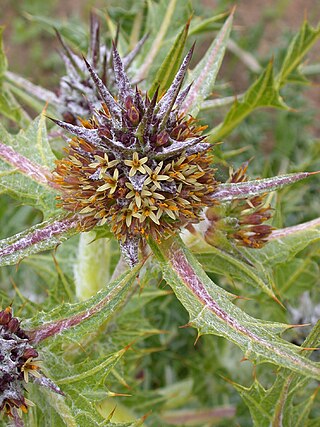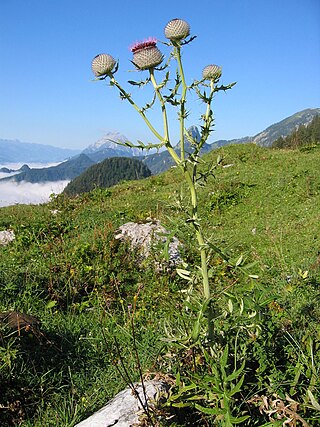
Gundelia is a low to high (20–100 cm) thistle-like perennial herbaceous plant with latex, spiny compound inflorescences, reminiscent of teasles and eryngos, that contain cream, yellow, greenish, pink, purple or redish-purple disk florets. It is assigned to the family Asteraceae. Flowers can be found from February to May. The stems of this plant dry-out when the seeds are ripe and break free from the underground root, and are then blown away like a tumbleweed, thus spreading the seeds effectively over large areas with little standing vegetation. This plant is native to the eastern Mediterranean and the Middle-East. Opinions differ about the number of species in Gundelia. Sometimes the genus is regarded monotypic, Gundelia tournefortii being a species with a large variability, but other authors distinguish up to nine species, differing in floret color and pubescence. Young stems are cooked and eaten in the Middle-East and are said to taste like a combination of artichoke and asparagus. The plant also contains compounds that have been demonstrated to be effective against a range of ailments. A large quantity of pollen assigned to Gundelia has been found on the Shroud of Turin, which may suggest that the crown of thorns was made from Gundelia.

Cirsium eriophorum, the woolly thistle, is a herbaceous biennial species of flowering plant in the genus Cirsium of the family Asteraceae. It is widespread across much of Europe. It is a large biennial plant with sharp spines on the tips of the leaves, and long, woolly hairs on much of the foliage. The flower heads are large and nearly spherical, with spines on the outside and many purple disc florets but no ray florets.

Barnadesia is a genus of flowering plants in the aster family, Asteraceae. It is native to South America, where it is distributed from Colombia to northern Argentina, with most species occurring in the Andes. Common names include clavelillo, chivo caspi, espino de gato, and espino santo.

Layia carnosa is a species of flowering plant in the family Asteraceae known by the common name beach tidytips, or beach layia. It is endemic to California, where it lives in beach habitat. It is known from several areas of mostly fragmented coastal habitat, and it was listed as an endangered species in California. On March 31, 2022, the category was changed from endangered species to threatened species by the US Department of the Interior Fish and Wildlife Service.

Layia chrysanthemoides is a species of flowering plant in the family Asteraceae known by the common name smooth tidytips, or smooth layia.

Layia gaillardioides is a species of flowering plant in the family Asteraceae known by the common name woodland tidytips.
Layia jonesii is a species of flowering plant in the family Asteraceae known by the common name Jones' tidytips, or Jones' layia.
Layia leucopappa is a rare species of flowering plant in the family Asteraceae known by the common name Comanche Point tidytips, or Comanche Point layia.
Layia munzii is a rare species of flowering plant in the family Asteraceae known by the common name Munz's tidytips, or Munz's layia.

Eupatorium japonicum, known as fragrant eupatorium in English and 白头婆 bai tou po, in Chinese, is a herbaceous plant species in the family Asteraceae. It is native to China, Japan and Korea.

Blepharizonia is a genus of flowering plants in the family Asteraceae. There are two species, both endemic to California. They are known generally as big tarweeds.
Brachythrix is a genus of flowering plants in the family Asteraceae. They are native to tropical south-central and eastern Africa.

Now known correctly as Archidasyphyllum diacanthoides. Common names in Mapudungun: Trevo and Tayu and in Spanish Palo Santo and Palo Blanco is a species of tree belonging to the family Asteraceae and endemic to Chile and Argentina. It occurs from Curico to Chiloe between 200 and 800 m above sea level. It grows in both moist and shaded sites and more open and arid areas.

Pyrrocoma racemosa is a species of flowering plant in the family Asteraceae known by the common name clustered goldenweed. It is native to the western United States, where it grows in many types of habitat. It is quite variable in morphology, and there are several varieties which are sometimes hard to tell apart. In general, it is a perennial herb usually producing two or more mostly erect stems reaching maximum heights between 15 and 90 centimeters. The stems are reddish or brownish in color, leafy or not, and hairless to quite woolly. The longest leaves are located in tufts around the base of the stems. They are lance-shaped to oval, smooth-edged, wavy, or deeply spine-toothed, and may exceed 30 centimeters in length. Basal leaves are borne on woolly petioles. Leaves located higher on the stem lack petioles and may clasp the stem at their bases. The inflorescence is a cluster of several flower heads lined with phyllaries which may be over a centimeter long and are hairy to hairless in texture. Each head contains many yellow disc florets and a fringe of several yellow ray florets. The fruit is an achene which may be over a centimeter long including its pappus.

The Stifftioideae are a subfamily of the family Asteraceae family of flowering plants. It comprises a single tribe, Stifftieae, of ten genera.
Pentacalia todziae is a plant species endemic to Perú, known only from San Martín Province.

Scolymus grandiflorus is a spiny annual or biennial plant in the family Asteraceae, native to the Mediterranean region. With up to 75 cm high stems, it is the smallest of the species of Scolymus. Its stems are lined with uninterrupted spiny wings. It also has the largest flowerheads in the genus, of approximately 5 cm wide. It has yellow, sometimes yolk-yellow ligulate florets. Its vernacular name in Maltese is xewk isfar kbir, meaning "large yellow fin", cardogna maggiore in Italian, scoddi on Sicily, and scolyme à grandes fleurs in French.
Famatinanthus is a genus in the family Asteraceae that was described in 2014 and has been assigned to its own tribe Famatinantheae and subfamily Famatinanthoideae. It contains only one known species, F. decussatus, a small shrub of ½—1¾ m high that is an endemic of the Andes of north-western Argentina, with small, entire, oppositely set leaves and flowerheads containing about ten cream-colored, ray and disk florets, with backward coiled lobes. It is locally known as sacansa. For more than 100 years, the species was known to science only from the type collection. It was described in 1885 and originally assigned to the genus Aphyllocladus.

Felicia heterophylla is a roughly hairy annual plant in the family Asteraceae. It has alternate leaves of 1–5 cm long with an entire margin or few inconspicuous teeth. The flower heads are set individually at the tip of its stems, and contain a whorl of purplish blue ray florets around a center of blackish blue disk florets. Flower heads appear in winter and spring. It is called true-blue daisy in English and bloublomastertjie in Afrikaans. It is an endemic species that only occurs in the Western Cape province of South Africa.

Mairia burchellii is a tufted perennial plant of up to 15 cm (6 in) assigned to the family Asteraceae. It has narrow leaves of up to 5 mm (0.20 in) wide, with single main vein and an entire margin. Flower heads only occur after a fire has destroyed the standing vegetation, mostly in November or between February and June. The flower heads sit individually or with a few on the tip of a purplish stalk, with a few narrow bracts, and consist of a row of pinkish ray florets around many yellow disc florets. It can be found in the southwest of the Western Cape province of South Africa.

















